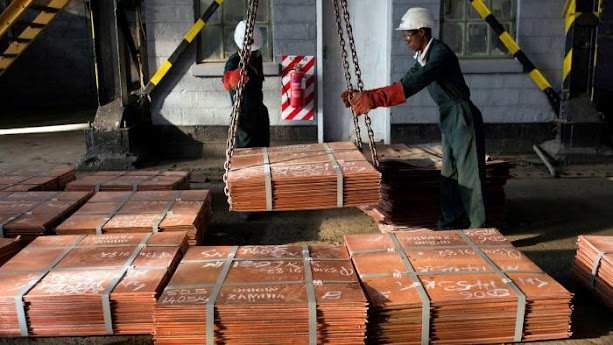The world isn’t prepared for a wave of sovereign debt defaults
Many emerging markets will need painful bond writedowns from China and private creditors
Alan Beattie
 Zambia and Sri Lanka have been hit by the heavy cost of infrastructure and falling export earnings from copper © Per-Anders Pettersson/Getty
Zambia and Sri Lanka have been hit by the heavy cost of infrastructure and falling export earnings from copper © Per-Anders Pettersson/GettyThe World Bank isn’t often given to making specific prophesies of doom as opposed to wringing its hands and talking vaguely about risk.
So it’s quite something when it bluntly talks of a “coming spate of debt crises” in emerging markets.
It’s not wildly surprising that we’re on the brink of a string of defaults.
The end of a long period of super-low global interest rates, the blow to growth from the pandemic, the huge uncertainty arising from Russia’s invasion of Ukraine, particularly the shock to net commodity importers from rocketing fuel and food prices, and the rise in the dollar have rapidly increased the burden of dollar-denominated debt.
It’s important to keep this in context and not start turning it into a morality play about feckless developing country governments.
Pre-pandemic, emerging markets didn’t go on an borrowing binge en masse.
Nor is the spate a tsunami: the World Bank reckons we won’t see an episode to match the Latin American crisis of the 1980s nor the heavily indebted poor countries (HIPC) phenomenon of the 2000s.
Still, the vulnerable and those who have made policy mistakes are certainly getting hit.
Apart from Russia itself, Zambia and Sri Lanka among others have already defaulted, in their cases hit by the heavy cost of infrastructure and falling export earnings from, respectively, copper and tourism.
More, particularly in sub-Saharan Africa, are heading the same way.
When the wave hits, are lenders and institutions such as the IMF ready to resolve these problems in a constructive and growth-friendly way?
You might think that after decades — indeed centuries — of practice, creditor countries would have worked out a predictable and reasonable way of restructuring sovereign bonds.
You would have reckoned without the shifting nature of international capital flows and the disorganisation of creditors.
And this time there’s a big new factor in the shape of China.
There have been multiple attempts to regularise sovereign restructuring to achieve fair burden-sharing between creditors.
The “London Club” of commercial banks was set up in 1976, when much sovereign borrowing was via bank loans, and was heavily used during the sovereign debt crises of the 1980s.
But it hasn’t really been relevant after borrowing shifted to capital markets.
For official creditors, the “Paris Club” was created in 1956 to address a debt crisis in — where else? — the serial defaulter Argentina.
The Paris Club played a key role in resolving episodes like the HIPC debt relief initiative, but has always struggled with compelling private sector creditors also to write down sovereign debt.
Twenty years ago, the IMF heroically tried but failed to set up an official bankruptcy procedure (the sovereign debt restructuring mechanism) to bail in private investors.
Borrowers have increasingly added clauses to sovereign bond contracts to ease restructuring, but they have imperfect coverage and effectiveness.
Sovereign bankruptcies with official bailouts and private creditors are still worked out ad hoc, sometimes with rival creditor committees.
Resolution can get particularly protracted when litigious distressed debt investors get involved.
The EU tried to set up its own formal arrangement to include private creditors in restructuring, the Deauville proposal, in 2010 in the middle of the eurozone debt crisis.
But it was handled as shambolically as the official rescue process in general and was eventually ditched.
The G20 of leading economies created a Common Framework for Debt Treatments during the pandemic in 2020, but it’s too vague to provide certainty.
So the new wave of defaults will be addressed with the usual jury-rigged creditor framework even before adding the uncertainty of China’s emergence as a major official bilateral creditor.
China is not a member of the Paris Club, part of its continued reluctance to join groups led by rich countries.
Its lending comes from a variety of state agencies with different approaches, including politically driven infrastructure developments in the Belt and Road Initiative.
It prefers to negotiate debt relief piecemeal, bilaterally and in private.
The resolution of debt crises is one of the policy areas and institutions (the World Trade Organization being another), in which an increasingly powerful China is often accused of opacity, disregard for multilateral principles and a general refusal to play the game.
Often it’s a reasonable criticism, but on the other hand the rich countries can hardly pride themselves on the rules they’ve devised for restructuring — especially in addressing private creditors, who generally hold bigger chunks of sovereign debt in several African countries than China does.
Resolving the forthcoming emerging market debt crisis is likely to be even slower and more painful than usual now that China is involved.
This would be a good opportunity to work out a more systematic treatment that will bind all creditors, public and private.
But the experience of China in other policy forums, and the weakness of efforts even before it became a major creditor, suggests that’s not exactly the most likely outcome.
Defaulters must brace themselves for tricky negotiations ahead.
0 comments:
Publicar un comentario